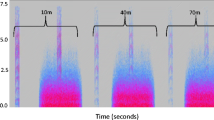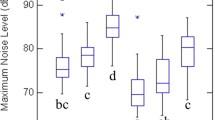Abstract
The effects of disturbance frequency, pedestrian group size, history and approach distance were tested through standardised approaches to 148 brooding/guarding wandering albatrosses (Diomedea exulans) at Marion Island in 2006. Seldom-visited birds were approached at different frequencies over a 3-day period and chick survival was monitored 2 weeks later. Two-person approaches were made to some seldom-visited birds and to birds that have recently been bled. Birds close to the station and in a long-term study colony were also approached. non-vocal response (NVR), vocal response (VR) and overall response (OR) of individuals were analysed. Frequency of approach did not influence short-term behavioural responses, but affected chick survival significantly—nests approached most often had the highest proportion of failures. Over the long-term, there was sensitisation to disturbance. Low OR ranks were found for 71.7% of seldom-disturbed birds, 41.7% of study colony birds and 28.6% of birds close to the station. Management regulations at the island are likely to be effective in protecting this species from human disturbance.

Similar content being viewed by others
References
Abrams PA (1993) Why predation rate should not be proportional to predator density. Ecology 74:716–733
Arroyo B, Razin M (2006) Effect of human activities on bearded vulture behaviour and breeding success in the French Pyrenees. Biol Conserv 128:276–284
Astheimer LB, Buttemer WA, Wingfield JC (1992) Interactions of corticosterone with feeding, activity and metabolism in passerine birds. Ornis Scand 23:355–365
Beale CM, Monaghan P (2004a) Human disturbance: people as predation-free predators? J Appl Ecol 41:335–343
Beale CM, Monaghan P (2004b) Behavioural responses to human disturbance: a matter of choice? 68:1065–1069
BirdLife International (2006) Threatened birds of the world 2006. Downloaded from http://www.birdlife.org on 04 May 2006
Blackmer AL, Ackerman JT, Nevitt GA (2004) Effects of investigator disturbance on hatching success and nest-site fidelity in a long-lived seabird, leach’s storm-petrel. Biol Conserv 116:141–148
Blumstein DT (2006) Developing an evolutionary ecology of fear: how life history and natural history traits affect disturbance tolerance in birds. Anim Behav 71:389–399
Blumstein DT, Anthony LL, Harcourt R, Ross C (2003) Testing a key assumption in wildlife buffer zones: is flight initiation distance a species-specific trait? Biol Conserv 110:97–100
Booth BP, Bio RP (2001) Southern Vancouver Island marine waters and seabird islands important bird areas conservation plan. Canadian Nature Federation, Bird Studies, Canada, Prince George
Burger J, Gochfeld M (1999) Role of human disturbance in response behavior of laysan albatrosses (Diomedea immutabilis). Bird Behav 13:23–30
Burger J, Gochfeld M (2007) Responses of emperor penguins (Aptenodytes forsteri) to encounters with ecotourists while commuting to and from their breeding colony. Polar Biol 30:1303–1313
Chown SL, Davies S, Joubert L (2006) Prince Edward Islands environmental management plan version 0.1. DST-NRF Centre of Excellence for Invasion Biology, Univ Stellenbosch, Stellenbosch
Conomy JT, Dubovsky JA, Collazo JA, Flemming WJ (1998) Do blood ducks and wood ducks habituate to aircraft disturbance? J Wildl Manage 62:1135–1142
Côté SD (2000) Aggressiveness in king penguins in relation to reproductive status and territory location. Anim Behav 59:813–821
Crawford RJM, Cooper J (2003) Conserving surface-nesting seabirds at the Prince Edward Islands: the roles of research, monitoring and legislation. Afr J Mar Sci 25:415–426
Davis PB (1995) Antarctic visitor behaviour: are guidelines enough? Polar Rec 31:327–334
de Villiers MS, Cooper J, Ryan PG (2005) Individual variability of behavioural responses by wandering albatrosses (Diomedea exulans) to human disturbance. Polar Biol 28:255–260
Ellenberg U, Mattern T, Seddon PJ, Jorquera GL (2006) Physiological and reproductive consequences of human disturbance in humboldt penguins: the need for species-specific visitor management. Biol Conserv 133:95–106
Erwin MR (1989) Responses to human intruders by birds nesting in colonies: experimental results and management guidelines. Colonial Waterbirds 12:104–108
Fowler GS (1999) Behavioural and hormonal responses of Magellanic penguins (Spheniscus magellanicus) to tourism and nest site visitation. Biol Conserv 90:143–149
Frid A, Dill LM (2002) Human-caused disturbance stimuli as a form of predation risk. Conserv Ecol 6:11 (online) URL: http://www.consecol.org/vol6/iss1/art11
Gales R, Brothers N, Reid T (1998) Seabird mortality in the Japanese tuna long-line fishery around Australia, 1988–1995. Biol Conserv 86:37–56
Geist C, Liao J, Libby S, Blumstein DT (2005) Does intruder group size and orientation affect flight initiation distance in birds? Anim Biodivers Conserv 28:69–73
Gill JA (2007) Approaches to measuring the effects of human disturbance on birds. Ibis 149(Suppl 1):9–14
Gill JA, Norris K, Sutherland WJ (2001) Why behavioural responses may not reflect the population consequences of human disturbance. Biol Conserv 97:265–268
Göttmark F (1992) The effects of investigator disturbance on nesting birds. In: Power M (ed) Current ornithology, vol 9. Plenum Press, New York, pp 63–104
Government of South Georgia and the South Sandwich Islands (2006) Plan for Progress, Managing the environment 2006–2010, South Georgia, 74 p
Holmes ND (2007) Comparing king, gentoo, and royal penguin responses to pedestrian visitation. J Wildl Manage 71:2575–2582
Holmes N, Giese M, Kriwoken LK (2005) Testing the minimum approach distance guidelines for incubating royal penguins Eudyptes schlegeli. Biol Conserv 126:339–350
Holmes ND, Giese M, Achurch HA, Robinson SA, Kriwoken LK (2006) Behaviour and breeding success of gentoo penguins Pygoscelis papua in areas of high and low human activity. Polar Biol 29:399–412
Holmes ND, Giese M, Kriwoken LK (2007) Linking variability in penguin responses to pedestrian activity for best practice management on subantarctic Macquarie Island. Polarforschung 77:7–15
IAATO (2007) IAATO marine wildlife watching guidelines Part 2. http://www.iaato.org/docs/Marine_Mammal-2.pdf
Knight RL, Cole DN (1995) Factors that influence wildlife responses to recreationists. In: Knight RL, Gutzwiller KJ (eds) Wildlife and recreationists: coexistence through management and research. Island Press, Washington, pp 71–79
Müllner A, Linsenmair KE, Wikelski M (2004) Exposure to ecotourism reduces survival and affects stress response in hoatzin chicks (Opisthocomus hoazin). Biol Conserv 118:549–558
Nel DC, Taylor F, Ryan PG, Cooper J (2003) Population dynamics of the wandering albatross Diomedea exulans at Marion Island: long-line fishing and environmental influences. Afr J Mar Sci 25:503–518
Nimon AJ, Schroter RC, Stonehouse B (1995) Heart rate of disturbed penguins. Nature 374:415
Perkins KA, Roth RR, Bowman JL, Green J (2004) Flushing, capture, and bleeding do not affect return rate of female wood thrushes (Hylocichla mustelina) in Delaware. Auk 121:354–360
Pitman DL, Ottenweller JE, Natelson BH (1988) Plasma corticosterone levels during repeated presentation of two intensities of restraint stress: chronic stress and habituation. Physiol Behav 43:47–55
Prince Edward Islands Management Plan Working Group (1996) Prince Edward Islands management plan. Department of Environmental Affairs and Tourism, Pretoria, South Africa
Prince PA, Weimerskirch H, Huin N, Rodwell S (1997) Molt, maturation of plumage and ageing in the Wandering Albatross. Condor 99:58–72
Rees EC, Bruce JH, White GT (2005) Factors affecting the behavioural responses of whooper swans (Cygnus c. cygnus) to various human activities. Biol Conserv 121:369–382
Robertson CR (1998) Factors influencing the breeding performance of the northern royal albatross. In: Robertson G, Gales R (eds) Albatross biology and conservation. Surrey Beatty, Chipping Norton, pp 99–104
Rodgers JA, Smith HT (1995) Set-back distances to protect nesting bird colonies from human disturbance in Florida. Conserv Biol 9:89–99
Rodgers JA, Smith HT (1997) Buffer zone distances to protect foraging and loafing waterbirds from human disturbance in Florida. Wildl Soc Bull 25:139–145
Ryan PG, Boix-Hinzen C (1998) Tuna long-line fisheries off southern Africa: the need to limit seabird by catch. S Afr J Sci 94:179–182
Tasmanian Parks and Wildlife Service (TPAWS) (2003) Parks and places. Macquarie Island world heritage area minimum impact code. Tasmanian Parks and Wildlife Service, Hobart
Tickell WLN (2000) Albatrosses. Pica Press, Sussex
van Heezik Y, Seddon PJ (1990) Effect of human disturbance on beach groups of jackass penguins. S Afr J Wildl Res 20:89–93
van Polanen Petel T, Giese M, Hindell M (2008) A preliminary investigation of the effect of repeated pedestrian approaches to weddell seals (Leptonychotes weddellii). Appl Anim Behav Sci 112:205–211
Walker BG, Boersma PD, Wingfield JC (2005a) Field endocrinology and conservation biology. Integr Comp Biol 45:12–18
Walker BG, Boersma PD, Wingfield JC (2005b) Physiological and behavioral differrences in Magellanic penguin chicks in undisturbed and tourist-visited locations of a colony. Conserv Biol 19:1571–1577
Walker BG, Boersma PD, Wingfield JC (2006) Habituation of adult Magellanic penguins to human visitation as expressed through behavior and corticosterone secretion. Conserv Biol 20:146–154
Watkins BP (1987) Population sizes of king, rockhopper and macaroni penguins and wandering albatrosses at the Prince Edward Islands and Gough Island, 1951–1986. S Afr J Antarct Res 17:150–157
Weimerskirch H, Lequette B, Jouventin P (1989) Development and maturation of plumage in the wandering albatross Diomedea exulans. J Zool (Lond) 219:411–421
Weimerskirch H, Shaffer SA, Mabille G, Martin J, Butard O, Rouanet JL (2002) Heart rate and energy expenditure of incubating wandering albatrosses: basal levels, natural variation, and the effects of human disturbance. J Exp Biol 205:475–483
Yorio P, Boersma PD (1992) The effects of human disturbance on Magellanic penguin Spheniscus magellanicus behaviour and breeding success. Bird Conserv Int 2:161–173
Zar JH (1999) Biostatical analysis, 4th edn. Prentice Hall, Upper Saddle River
Acknowledgments
The South African National Antarctic Programme (SANAP), Department of Environmental Affairs and Tourism, provided permission to conduct research and logistic support. Mariëtte Wheeler held a National Research Foundation (NRF) Prestigious PhD bursary and M.S. de Villiers received an NRF grant towards this research. Res Altwegg assisted with the statistical modelling.
Author information
Authors and Affiliations
Corresponding author
Rights and permissions
About this article
Cite this article
Wheeler, M., de Villiers, M.S. & Majiedt, P.A. The effect of frequency and nature of pedestrian approaches on the behaviour of wandering albatrosses at sub-Antarctic Marion Island. Polar Biol 32, 197–205 (2009). https://doi.org/10.1007/s00300-008-0520-2
Received:
Revised:
Accepted:
Published:
Issue Date:
DOI: https://doi.org/10.1007/s00300-008-0520-2




